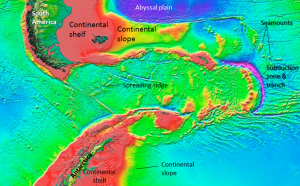Chapter 14 Answers
Review Question Answers:
- Most of the sediments on continental shelves originate from clastic sediments derived from erosion on the continents. The shelves on the eastern coast of North America are wider than those along the west coast because there has been relatively recent (Cenozoic) tectonic activity on the west coast, while the east coast has been passive for about 180 million years.
- Subduction zone trenches may be partly filled in areas where there is significant sediment input from rivers.
- From bottom to top, oceanic crust is composed of gabbro, sheeted mafic dykes, and pillow basalts. In most areas it is also covered with varying amounts of sea-floor sediments and sedimentary rocks.
- The oldest sea floor in the Indian Ocean is in the order of 150 Ma. There is oceanic crust of this age along the western margin of Africa, and adjacent to the northwestern part of Australia.
- Coarse terrigenous sediments accumulate mostly where major rivers enter the sea, but they are only washed a few kilometres out to sea (at most) because there isn’t enough river velocity left to move them farther. Some of those sediments are moved many kilometres farther out to sea during flows of turbidity currents. Clay, on the other hand, can stay in suspension for centuries, and during that time can be dispersed well out into the ocean.
- Carbonate sediments will accumulate on the sea floor wherever there is significant abundance of carbonate-shelled organisms near to surface, and where the ocean is shallower than the depth at which carbonate becomes soluble (the carbonate compensation depth). In these areas there is typically much more carbonate than clay present, so the sediments look carbonate-rich, even though there is clay there.
- Carbonate sediments are absent from the deepest parts of the oceans because carbonate minerals are soluble below about a 4,000 meter depth, so carbonate fragments that settle to that depth dissolve back into the water.
- The carbon in sea-floor methane hydrates is derived from the bacterial breakdown of organic matter at greater depth in the sediment pile.
- The tropical parts of the oceans are saltiest because the rate of evaporation is highest. The Mediterranean and Red Seas are saltier than the open ocean.
- Salty water is transported north by the Gulf Stream and gradually cools. As it cools it remains relatively salty and this cool salty is denser than either cold very fresh water or warm very salty water.
- The relatively dense water in the north Atlantic sinks to become North Atlantic Deep Water (NADW), and gradually moves back towards the south.
- The open-ocean currents have the effect of moderating Earth’s surface temperature because warm tropical water is moved toward the poles, and cold polar water is moved toward the tropics.
Exercise Answers:
Exercise 14.1 Visualizing sea-floor topography
- see map, below
- This is the area between the southern tip of South America (Cape Horn) and the Antarctic Peninsula. The body of water between the two is the Drake Passage.

[Image from NASA/CNES at: http://topex.ucsd.edu/marine_topo/jpg_images/topo16.jpg] Exercise 14.2 The age of subducting crust
- The oldest is in the southeast and is greater than 8 Ma (see map below).
- The youngest is in the north and is close to 0 Ma.
![[SE]](https://opentextbc.ca/physicalgeology2ed/wp-content/uploads/sites/298/2019/08/ex18-2-228x300.png)
[Image by Steven Earle] Exercise 14.3 What type of sediment
-
- siliceous ooze or clay
- carbonate ooze
- siliceous ooze or clay
- coarse terrigenous or carbonate ooze
![[SE]](https://opentextbc.ca/physicalgeology2ed/wp-content/uploads/sites/298/2019/08/ex18-3-300x96.png)
[Image by Steven Earle] Exercise 14.4 Salt chuck
No answer possible.
Exercise 14.5 Understanding the Coriolis effect
No answer possible.
Licenses and Attributions
“Physical Geology – 2nd Edition” by Steven Earle is licensed under CC BY 4.0 Adaptation: Renumbering, Remixing

